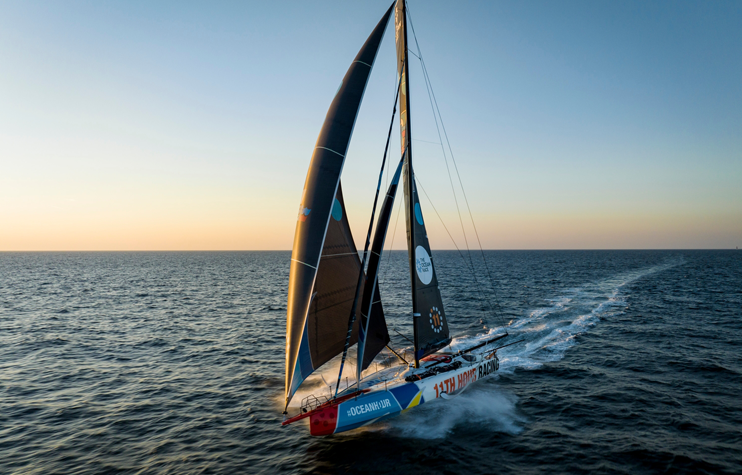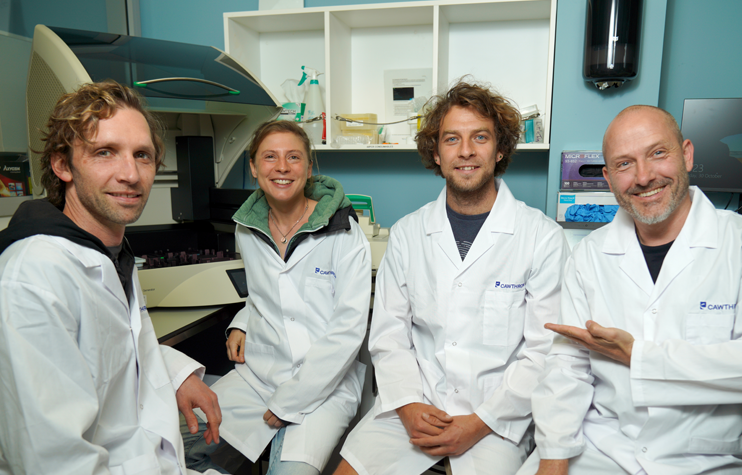
2 November 2023
It was Fabrice Amedeo’s fourth time sailing the Route de Rhum. The solo race runs 3542 nautical miles, from Guadeloupe in the Southern Caribbean to the port of Saint-Malo in France. He set out on November 9, 2022; if all went well, his 60-foot yacht, the Nexans – Art et Fenêtres, could cross the Atlantic in seven days.
On day four, his ballast exploded. The boat began filling with water; its batteries and electronics failed. Abandoning the race course, Amedeo diverted east to make landfall as soon as possible. Then on day six, another explosion. The cockpit filled with flames and yellow smoke. Amedeo tumbled into his life raft and watched as the yacht sank beneath the waves. After a few hours of helpless drifting, he was able to contact a container ship passing nearby, which came to his rescue. “Death did not want me today,” he later told Yachting World.
In the chaos of the fire, all Amedeo could save from the yacht was his emergency radio and his wedding ring. The scientific equipment he’d had aboard—including an environmental DNA (eDNA) collection kit, and all the samples he’d taken so far—went straight to Davy Jones’ locker.
Turning racers into field scientists
The eDNA kit was the latest iteration of a project from the molecular surveillance team at New Zealand’s Cawthron Institute, led by Xavier Pochon. The institute specializes in science that supports the environment and sustainable development, and Pochon’s team monitors natural ecosystems using DNA metabarcoding, which inspects an environmental sample for both microbes and cells shed by larger organisms, whether those species are previously known or novel. And when it comes to marine biodiversity, Pochon saw a pressing need for more data.
“We greatly lack biological data from the four corners of the world,” he says. “We have amazing models that predict future impacts of climate change, but none of them contain near-real-time biological data collected at sea. If you want to make sense of climate change and understand how marine communities are changing, it’s urgent and essential to look for strong spatiotemporal data.”
Traditional oceanographic research methods require direct visual observation or even physical capture of the species involved, which is slow, expensive, and can be harmful to marine life. Pochon came up with the idea to equip sport sailing vessels with user-friendly tools and a simple procedure for taking seawater samples at key points along their route—a faster, more reliable, and harmless way to track endangered species, monitor pathogens and, over time, show how climate change is shifting species’ geographic range.
Pochon says that sport sailors are a natural fit for this task: “They deeply care about the ocean, because they spend a lot of time out there. They have a deep knowledge on how the environment changes and a thirst for helping science in any way they can.”
His team debuted their first generation of eDNA filtering kits in 2015, but they required the boats to slow to two knots—practically a dead stop. The next version took on a sleeker, torpedo-like shape, which could be dragged behind a boat at up to 12 knots. This was an improvement . . . but racing yachts can speed along at 35 knots. “You can imagine, you’re not going to tow anything behind those vessels,” Pochon says.
One breakthrough came thanks to Austen Thomas, a research scientist at Smith-Root, which had invented capsules that could easily filter a few liters of water and then automatically dry the eDNA, enabling the sample to be sent to a lab at room temperature.
Another came in 2021, when Pochon contacted Fabrice Amedeo, who already collected environmental variables during his races using OceanPack, an “autonomous underway measurement system” that constantly collects data on salinity, temperature, CO2, and dissolved oxygen—even at 35 knots. Pochon convinced Amedeo to add eDNA collection to his races, using their latest filter kit.

DNA collection for beginners
Amedeo’s shipwreck turned out to be just a temporary setback, both for him and for the Cawthron Institute scientists. Shortly after the Route de Rhum, Pochon was contacted by Stefan Raimund, principal ocean science advisor at The Ocean Race. The grueling six-month, 32,000-mile race around the world is the only sporting event that requires all teams to participate in a science program. All five competitors were already set to collect other kinds of environmental data en route, and the one flying the American flag, 11th Hour Racing Team, was interested in using the eDNA kit as well.
Onboard reporter Amory Ross would use the kit during the race’s fourth leg, from Itajai, Brazil, to Newport, Rhode Island, from April 23 to May 10, 2023. They chose this leg because it covered the broadest range of latitudes and sea surface temperatures.
Ross took samples at nine regular intervals. The new kit minimized hands-on time, requiring only a brief diversion in the water flow to the systems measuring other variables. He’d hook up a capsule to the filter, pass two liters of water through, use a manual air pump for one minute to dry the sample, then bag it and label it with their current coordinates.
This time, the plan went off without a hitch. Not only did 11th Hour recover high-quality samples, they also won the race. “This really resonates to me,” Pochon says, “because for the longest time the dialogue was, ‘You either focus on the race or you gather environmental data.’ But you can do both.” Here was proof that racing boats could conduct this kind of scientific work without sacrificing any speed. In addition to eDNA, the competitors in the 2022–23 race took over 4 million measurements of environmental data and hundreds of samples of marine plastic.

The depths revealed
What secrets of the fathomless deep were waiting to be decoded in 11th Hour’s samples? With support from Illumina, Sequench, and Smith-Root, Cawthron Institute’s molecular surveillance team got right to work, extracting 4.7 million DNA sequences and identifying 11,000 species—all in less than two weeks.
Thanks to data already available in public databases, they could use metabarcoding to positively identify organisms from across the tree of life, all the way down to the species level. Even if they came across a previously unidentified species, they could still zero in on its genus.
They screened the samples using four genetic markers: one for bacteria, one for all eukaryotes (that is, any life form with a cell nucleus), one for animals, and one specifically targeting fish and mammals. The diversity they found was astounding—flying fish; deep-sea lancetfish; lanternfish (“Everything from squid to seabirds and whales feed on lanternfish,” Pochon says); the Argentine anchovy, which is at risk from overfishing; a dazzling variety of jellyfish; the elusive moray eel, which migrates thousands of miles to spawn, over routes that remain a mystery; and several kinds of copepods, tiny crustaceans that constitute a vital part of the food chain for most commercially important fish species.
The team was also hoping to find evidence of cetacean activity (dolphins and whales), but their data showed an unexpected abundance of human DNA that drowned out any other mammalian signals—the result of Ross forgetting to use gloves during sample collection.
By overlaying their eDNA dataset with the other variables the boats collected, Pochon’s team identified some areas of concern—for instance, they saw a higher incidence of bacteria involved in plastic degradation at lower latitudes, near Brazil; they saw that parasitic bacteria are strongly correlated with higher sea surface temperature; and they found high densities of Karlodinium veneficum, a toxic phytoplankton that’s associated with increased fish mortality.
The team is particularly interested in identifying invasive species, but Pochon acknowledges that “the full power of integrative analysis will take place once we’re able to equip as many boats as possible.”

Open waters, open access
Pochon hopes this data can be used to show every country in the world how climate change is affecting ocean biodiversity, and encourage governments and institutions to make more effective plans to forestall its collapse. “Oceanographic research vessels can’t go everywhere, but every day at least 10,000 boats are plying oceans all around the world,” he says. “What if you could equip these thousands of vessels with portable, super-simple tools and gather incredible biodiversity information in a much more effective way than we can do today? The technology keeps improving, getting smaller and faster and more hands-free.”
Eventually, the data could culminate in an open-access marine genomic database that could be parsed by users all over the world. “A lot of this—if not all of this—is thanks to biotechnology companies such as Illumina who have pushed the frontiers in the way we can monitor and screen the environment in depth. It’s such an exciting space to be in, because it’s evolving so fast we can hardly follow.”


